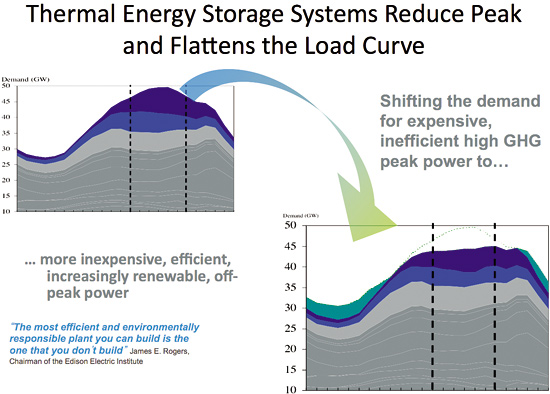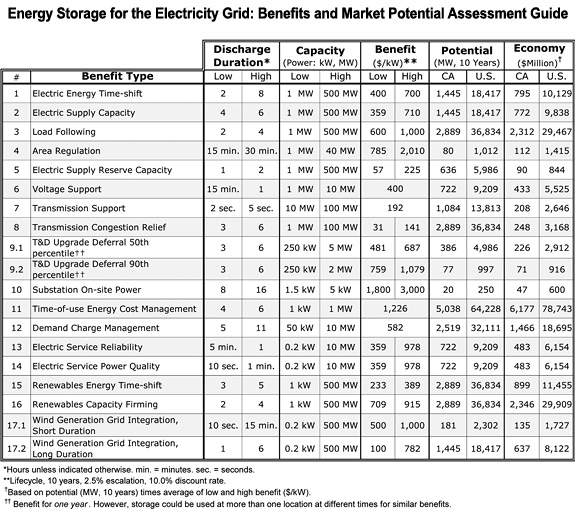There is much interest and attention given to the potential benefits of energy storage. Research, private and government investment, and regulatory policy forums have been focused on a range of storage issues. Nevertheless, real-world market implementation will not go very far unless a focus on the customer value proposition moves to the forefront of the discussion. Ultimately an economic environment - including market, regulatory and utility rates and incentives - needs to be better defined for the customer to justify storage at their facilities.
First, the Basics…
Energy storage (ES) systems store energy for use at a later time, when electric power is most needed and most expensive, such as on hot summer afternoons. Energy storage can come in the form of chemical, mechanical and thermal means of storing energy.
Unlike other commodity products or energy resources, electric energy can’t be easily stored directly as electric energy. The energy needs to be converted into a different form for storage. A battery, for example, uses a reversible electrochemical process. Pumped hydro uses gravitational potential differences. Thermal Energy Storage (TES) stores thermal energy, either cold or hot for later use. Delivering an electric energy benefit requires a second conversion process. Moreover, both the charging and discharging processes necessitate investment in the conversion technology, and both introduce inefficiencies, adding costs to the economics of storage systems. Thermal Energy Storage, for example, using chilled water or ice to reduce on peak electrical usage to off peak times has been a viable technology for over sixty years.
Growing higher price differences between on-peak and off-peak power, critical peak pricing strategies, targeted customer incentives and more renewable energy that is non-coincident with peak together can help various storage solutions to become much more economically feasible.
The Need for Storage
As you might expect, there is lots of research on energy supply and demand imbalances that will require alternative energy management, efficiency solutions, and some type of energy or thermal storage. For example, the North American Electric Reliability Corporation (NERC) reported that electricity demand in the United States is expected to increase by 135,000 MW in the next decade yet only 77,000 MW of new resources have been identified, creating a shortfall of 58,000 MW—an amount equivalent to 110 large power plants.
In theory, there would be minimal shortages of electricity and few distribution or transmission problems if it were possible to balance electric loads over a 24-hour day. In the real world however, there is a long list of contributors that disrupt balanced electric loads throughout a day and throughout the year.
Storage is also is a valuable tool for integration of a high volume of renewable energy because the resource often is not available at times of high-energy use. For large-scale renewable generation such as wind farms, energy storage may play a pivotal role in reaching reliability standards and meeting frequency and ramping requirements.
The need for energy storage will continue to expand due to a convergence of several issues, including the rising cost to site conventional generation and delivery assets, increased load growth and lower load factors, and the need to address weak points in the distribution system.
The Benefits of Energy Storage – Utility
Energy storage applications that achieve the highest estimated revenues do so by aggregating several benefits across multiple categories. Capturing multiple benefits—including transmission and distribution (T&D) deferral and ancillary services - will be critical for high-value applications.
Reduced need for peak generation capacity: By storing energy generated during off-peak times and discharging it during peak times, storage provides an alternative to the construction and operation of new generation and reserve capacity. Peak demand growth is a major concern for many electricity planners, exacerbated by the fact that populations in the hotter parts of the United States are growing fastest. The value of the avoided cost of peak generation capacity will continue to increase as peak demand grows and as carbon emissions become more expensive.

“The most efficient and environmentally responsible plant you can build is the one that you don’t build.”
– James E. Rogers, Chairman, President & CEO of Duke Energy
More efficient use of renewable and other off-peak generation: The development of wind energy has greatly expanded in the past few years, and more projects - including utility-scale wind farms – are being developed. Wind tends to blow most strongly at night, and for example, the California ISO predicts a serious mismatch of load and generation in the off-peak hours of 11 pm to 6 am, including as much as 3000 to 5000 MW of excess off-peak capacity. We have also seen some conflict between Bonneville Power Authority and wind energy producers in the Pacific Northwest due the BPA cutting off wind producers’ high volumes of generation when it is not needed. Rather than forcing renewable generators to curtail production, ES can allow excess wind and store it for use at later times.
Transmission support and/or distribution congestion relief: Storage can be used to improve system performance by alleviating problems like voltage sag and unstable voltage. In addition, it can help to avoid congestion by discharging in congested areas at times of peak demand.
Increased and improved availability of ancillary services: Ancillary services are services necessary to support the transmission of energy from generation resources to consumers, while maintaining the reliable operation of the transmission system. There are two primary types of ancillary services, which could be provided by storage, which are:
Frequency regulation, which ensures that the grid operates within an allowable range of interconnection frequencies, and;
Operating reserves, which ensure that more energy can be added to the system within a short period of time to meet unexpected increases in demand or reductions in supply.
Benefits for the Customer
Customer storage tends to be an application-specific resource, and therefore, the costs – as well as the resultant benefits – can vary greatly. Consequently, considerable diligence needs to be undertaken for customers to provide the necessary economic and operational rationale for them to expend their valuable capital. There is a long list of potential customer operational benefits ranging from better power quality and back up to enhanced indoor comfort and avoided capital costs. However, the clear primary focus is on the economic value to the customer and the ROI that can be expected for installing a particular technology.
Avoided Utility Costs
In its simplest form, customer savings can come from shifting demand to off-peak times or simple DR peak reduction. Both assume that the utility is offering reasonable Time-of-Use rates or Demand Response offsets. Storage enables customers to change when they draw power from the grid to meet their demand. For customers on dynamic rates – that is, TOU or Critical Peak Pricing (CPP) – storage allows energy arbitrage opportunities, whereby the system charges when the cost of energy is low and discharges when the cost of energy is high.
The economic value of this load shifting varies depending on the individual customer’s load shape and tariff, as well as the timing and frequency of when the load is shifted. Many commercial and industrial power customers have tariffs that consist of an energy charge, which is based on how many kilowatt-hours of energy have been used in a given time period, and a demand charge, which is based on the size of maximum demand within one month.
The installation of energy storage can result in cost effective reduction of energy charges if the spread between on-peak and off-peak time of use rates is large enough. Additional savings could come from reduced demand, provided that it reliably reduces the size of the customer’s maximum demand peak. Additional potential savings are available for Demand Response events if the storage system can be controlled to meet DR requirements.
Benefits Summary
- Reduces on-peak electrical demand
- Reduces energy costs for the building owner
- Reduction in source energy fuel consumption due to increased efficiency of generation, transmission and distribution assets during off peak hours when operating to meet a steady base load
- Enables intermittent renewable generation sources to be system capacity resources by firming their intermittency and providing load when these resources are most abundant
- With good TOU and DR rates it will produce increasing customer cost avoidance
- For TES, separates the use of cooling from the creation of cooling – more efficient and less costly at night
- Moves load to night generation – better load factor, environmental GHG benefits, use of renewables
And, for TES systems…
- Can earn Green Building Council LEED points by reducing building energy costs
- First cost can be minimized – improves payback, reduce size of chiller plant
- Larger delta T reduces system flow (smaller pumps, pipe size)
- Lower temp air distribution means fan motor and duct size savings
- Smaller electrical service needs (switch gear, transformers, motor control panels, distribution)
- Addresses increased capacity issues due to inefficiency, increased internal building loads potential 50% + increase from TES
- With increasing outdoor air needs, RH control TES can better maintain temp at full load
- Adds cooling capacity to existing ducts, fans and pumps
Regulation and the Evolution of DR
The Energy Independence and Security Act of 2007 required the Federal Energy Regulatory Commission to perform a national assessment of DR potential and to develop a national DR action plan. In its “2010 Assessment of Demand Response and Advanced Metering” staff report, FERC gave demand response a slightly new definition, redefining it as: “Changes in electric use by demand-side resources from their normal consumption patterns in response to changes in the price of electricity, or to incentive payments designed to induce lower electricity use at times of high wholesale market prices or when system reliability is jeopardized.” So far, adoption has been constrained in some states – and by some utilities – in part by existing state-level regulatory constructs.
California Takes the Lead
California has implemented several laws that have, in turn, shaped the storage marketplace. Reducing California air emissions to 1990 levels as mandated by the adopted Global Warming Solutions Act (AB 32) and reaching a targeted 33 percent Renewable Portfolio Standard (RPS) by 2020 present unprecedented challenges to utilities and their customers. The California legislature approved the Energy Storage Bill (AB 2514) in 2010, instituting a Public Utility Commission proceeding to establish a mandate for utilities to hold a percentage of their total generation capacity as dispatchable stored energy.
All forms of commercially ready energy storage technologies, including chemical, mechanical and thermal means of storing energy are eligible under AB 2514. While California has been involved in energy storage for past 10 years, AB 2514 places a much higher level of importance on energy storage.
California Utilities and Demand Response in the Real World
Southern California Edison and Pacific Gas and Electric have been designing, developing and deploying reliability and price-responsive demand response retail programs for more than 25 years. These programs include interruptible tariffs, direct load control, capacity-based retail products and dynamic dispatchable pricing.
For the last few years, SCE and PG&E have successfully used a program for peak load shift (PLS), using Thermal Energy Storage (TES). Thermal energy storage systems, which shift electricity for air conditioning and process cooling from on-peak to off-peak time periods, have proven to be one of the most cost-effective, reliable and feasible means to reduce critical on-peak demand and if applied properly can also achieve energy efficiency1. SDGE has also used this same program, but with a very different technology2 to permanently reduce peak usage.
This Cypress-managed peak load shift program is based on a proven model of a first cost buy-down incentive on capital equipment, clear customer communications, and hands-on market channel support to promote participation and economic justification. TES installations will be customized to customer demand profiles, financial requirements and factors such as local distribution system constraints determined to be critical by the utility to ensure that the program meets the exact needs of the utility.
Part of the value proposition for the customer for such a program is that they can purchase a TES system that reduces their peak costs at a discounted first cost, while also generating lower overall cost of operations and total utility costs. Financial models and collateral materials were also developed to provide this information to the customer in an easy-to-understand, financial format.
One program participant owns and operates a 24-story, 430,000 square foot office building that uses less than 50% of the energy per square foot compared to similar buildings in the area after installing a TES system. Moreover, the two 800-ton chillers never come on during the 10-hour daily air conditioning cycle when the building is being cooled by the TES system, and only one of the chillers is neded at night to charge the thermal storage system.
The following table provides a perspective on the range of storage benefit categories coupled with the savings and potential economic value of energy storage. All values are presented from the utility avoided-cost perspective.

SOURCE: Sandia Report (SAND2010-0815); February 2010
Utility Cost Avoidance vs. Tangible Customer Value
Utility avoided costs are important, but in the end, it’s the customer’s value that needs to be articulated. Even though a given kW and kWH offset using storage can have a high value to the utility, until the utility actually agrees with the value and either builds it into a rate structure or creates a customer incentive, as far as the customer is concerned, the potential value is just that... potential.
Depending on the installed cost of storage on a per kW and kWH basis, the existing TOU rates and emerging Critical Peak Price rates – coupled with existing DR incentives alone or the planned Peak Load Shift incentives – will generally support reasonable customer ROIs.
For either residential or small commercial energy storage, if the installed cost per kW delivered can be in the $750-$2000 range for a storage solution with a duration of 1-2 hours or a full Peak Load Shift with a duration of 2-6 hours (ideally 6 hours), then the end-use customer market opportunity is significant and immediate.
However, customers – even those equipped with advanced metering and enabling technology – have not readily adopted dynamic pricing and frequent dispatching of customer-approved load reductions. Overcoming these hurdles, will involve education and awareness, new ideas, additional program design, system improvements and enabling technologies to facilitate customer participation.
General Conclusions and Parting Thoughts
- There is no silver bullet solution for grid storage and several technology classes will be important. Thermal Energy Storage is proven and is usually cost effective form the customer perspective if there are TOU rates and/or utility incentives.
- There is no well established unified market channel for energy storage technologies, except for TES
- Unless the customer can count on a good ROI, the true potential for storage at least on the customer side of the meter, will not happen.
- The market for grid-based storage for behind the meter installations for commercial and industrial facilities is growing and significant
- End-users of energy storage systems will try to aggregate as many value streams as possible to maximize the total economic benefit of their energy storage investments.
- The tariffs must pull and influence the usage of electricity.
- For storage to be a customer investment, the rates must be reliable, and reasonably predictable
- One option for further analysis if to create special storage based tariffs charged for this commodity separate from any other influence except for what the commodity really costs
“It should be noted that energy storage is not an end solution by itself. Instead it should be viewed as an emerging part of a new smart grid. This new smart grid will utilize many different technologies, including two-way communication devices, advanced metrology, and customer energy management software. Storage is just one of the technologies that will help improve the grid along with these other advances.”3
About the Authors
 Tom Smolarek founded Cypress, Ltd. in 1990, and he provides executive support and overall direction for the company. His role includes organization of all client projects and Cypress partners, strategic development of the business, expansion of capital and additional resource acquisition, as well as oversight of quality and commitment fulfillment processes. Under Tom’s leadership, the business has successfully planned, launched and implemented various DSM programs and non-regulated energy services start-ups for a number of utilities and customer programs.
Tom Smolarek founded Cypress, Ltd. in 1990, and he provides executive support and overall direction for the company. His role includes organization of all client projects and Cypress partners, strategic development of the business, expansion of capital and additional resource acquisition, as well as oversight of quality and commitment fulfillment processes. Under Tom’s leadership, the business has successfully planned, launched and implemented various DSM programs and non-regulated energy services start-ups for a number of utilities and customer programs.
Prior to founding Cypress, Tom was Director and General Manager for Corporate Market Development for Square D Company (now Schneider Electric Company). Earlier in his career he held positions in General Management and Sales & Marketing Management at Honeywell, where he developed and managed both divisional and corporate sales development plans for its commercial energy business. Tom holds a BS-Pre-Med & Psychology and an MS in Psychology from the University of Wisconsin.
 Treena Colby serves as Vice President of Business Operations for Cypress, Ltd., where she is responsible for analyzing the developments within the energy and utility sectors; identifying and securing new opportunities; and overall Cypress marketing strategy. She brings a unique combination of research, writing, marketing, event/project management skills, and deep knowledge of clean technology clusters.
Treena Colby serves as Vice President of Business Operations for Cypress, Ltd., where she is responsible for analyzing the developments within the energy and utility sectors; identifying and securing new opportunities; and overall Cypress marketing strategy. She brings a unique combination of research, writing, marketing, event/project management skills, and deep knowledge of clean technology clusters.
Treena graduated from The Colorado College with a B.A. in Environmental Policy. She holds Board positions for the Network for Business Innovation and Sustainability (NBIS) and the Alumni Association Board for Colorado College.
1 Source energy reduction from 24-45%, Site energy 12-20% (non TDV, if TDV values can be higher depending on application, Emissions - source 30-50% from Source Energy and Environmental Impacts of Thermal Energy Storage, published by California Energy Commission.
2 SDG&E used Gas Cooling to permanently reduce peak demand which is not a storage technology but still has solid benefits for both peak reduction and GHG reductions
3 Moving Energy Storage from Concept to Reality: Southern California Edison’s Approach to Evaluating Energy Storage; Primary Authors: Johannes Rittershausen & Mariko McDonagh







